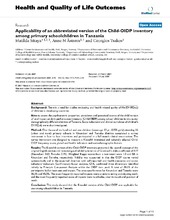| dc.contributor.author | Mtaya, Matilda | en_US |
| dc.contributor.author | Åstrøm, Anne Nordrehaug | en_US |
| dc.contributor.author | Tsakos, Georgios | en_US |
| dc.date.accessioned | 2014-12-05T09:40:13Z | |
| dc.date.available | 2014-12-05T09:40:13Z | |
| dc.date.issued | 2007-07-13 | eng |
| dc.identifier.issn | 1477-7525 | |
| dc.identifier.uri | https://hdl.handle.net/1956/8845 | |
| dc.description.abstract | Background: There is a need for studies evaluating oral health related quality of life (OHRQoL) of children in developing countries. Aim: to assess the psychometric properties, prevalence and perceived causes of the child version of oral impact on daily performance inventory (Child-OIDP) among school children in two sociodemographically different districts of Tanzania. Socio-behavioral and clinical correlates of children's OHRQoL were also investigated. Method: One thousand six hundred and one children (mean age 13 yr, 60.5% girls) attending 16 (urban and rural) primary schools in Kinondoni and Temeke districts completed a survey instrument in face to face interviews and participated in a full mouth clinical examination. The survey instrument was designed to measure a Kiswahili translated and culturally adapted Child- OIDP frequency score, global oral health indicators and socio-demographic factors. Results: The Kiswahili version of the Child-OIDP inventory preserved the overall concept of the original English version and revealed good reliability in terms of Cronbach's alpha coefficient of 0.77 (Kinondoni: 0.62, Temeke: 0.76). Weighted Kappa scores from a test-retest were 1.0 and 0.8 in Kinondoni and Temeke, respectively. Validity was supported in that the OIDP scores varied systematically and in the expected direction with self-reported oral health measures and sociobehavioral indicators. Confirmatory factor analyses, CFA, confirmed three dimensions identified initially by Principle Component Analysis within the OIDP item pool. A total of 28.6% of the participants had at least one oral impact. The area specific rates for Kinondoni and Temeke were 18.5% and 45.5%. The most frequently reported impacts were problems eating and cleaning teeth, and the most frequently reported cause of impacts were toothache, ulcer in mouth and position of teeth. Conclusion: This study showed that the Kiswahili version of the Child-OIDP was applicable for use among schoolchildren in Tanzania. | en_US |
| dc.language.iso | eng | eng |
| dc.publisher | BioMed Central | eng |
| dc.rights | Attribution CC BY | eng |
| dc.rights.uri | http://creativecommons.org/licenses/by/2.0 | eng |
| dc.title | Applicability of an abbreviated version of the Child-OIDP inventory among primary schoolchildren in Tanzania | en_US |
| dc.type | Peer reviewed | |
| dc.type | Journal article | |
| dc.date.updated | 2013-08-28T17:09:19Z | |
| dc.description.version | publishedVersion | en_US |
| dc.rights.holder | Copyright 2007 Mtaya et al; licensee BioMed Central Ltd. | |
| dc.rights.holder | Matilda Mtaya et al.; licensee BioMed Central Ltd. | |
| dc.source.articlenumber | 40 | |
| dc.identifier.doi | https://doi.org/10.1186/1477-7525-5-40 | |
| dc.identifier.cristin | 367844 | |
| dc.source.journal | Health and Quality of Life Outcomes | |
| dc.source.40 | 5 | |

